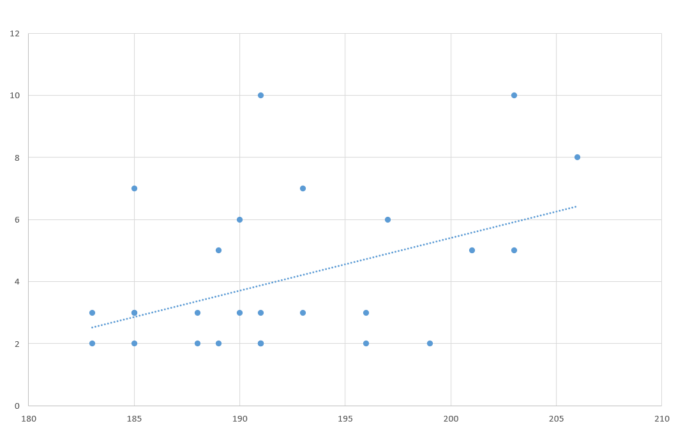A few years ago, someone told me that taller people are ‘of course’ stronger than smaller ones. A couple of days ago I suddenly wondered if that was actually true. It made sense at the time, and it still makes sense, and most of the strongmen whose carreer I follow are indeed quite lengthy. But was that proof enough? I decided to genuinely test the hypothesis with some data: is there a correlation between height and strenght?
Content
Stats based on strongmen with multiple WSM podium placements
I looked up all men who had multiple podiums wins in the yearly World Strongest Man contest. Why that specific contest? Simple: because it was the first I thought of. I coul’ve chosen another contest, for example the Arnolds, but it’s roughly the same batch of men competing in strongmen contests, so I think the same calculations based on another contest would be roughly the same. Because I wanted a fair amount of strongman data, I chose to use the table of men who had multiple top three finishes (gold, silver or bronze) in that competition, which concerns 28 men. I copied the table off of Wikipedia and looked up each man’s height. That resulted in this table:

The first thing we can notice is that the least tall men to have multiple WSM-podiums are 183 cm tall. As the highest average country-based lenght is that of the Dutch (the male average is 183,3 cm), we can immediately see that, on a world scale, that’s very tall indeed. The 26 others are even taller, with Hafþór Júlíus Björnsson being the tallest, with 206 cm, a good 23 cm more than Wolders and Taylor. Their average height is 191 cm, and the average amount of podium placings is 4. Of the above 28 men, 93% are taller than the Dutch male average.
Next, I used Excel to create a scatterplot, with height on the x-axis, and the number of podium placings on the y-axis. The trendline indeed indicates that there is a correlation.
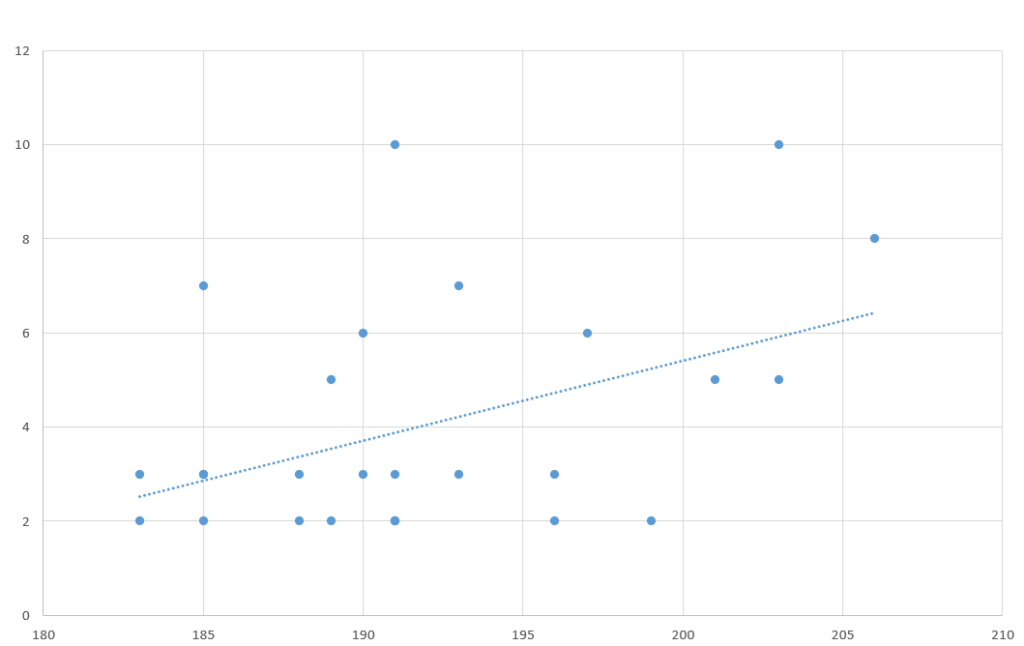
Stats based on strongmen with one or more WSM podium placement
When I showed the above to a friend, he remarked that he would’ve liked to see more data. So I decided to investigate the matter further and create some more statistics. To get a higher n, I decided to now base my statistics on every strongman that won at least one podium placement (gold, silver or bronze). I went to Wikipedia and made a new table based on their list of winners.
That resulted in a table containing 55 men.
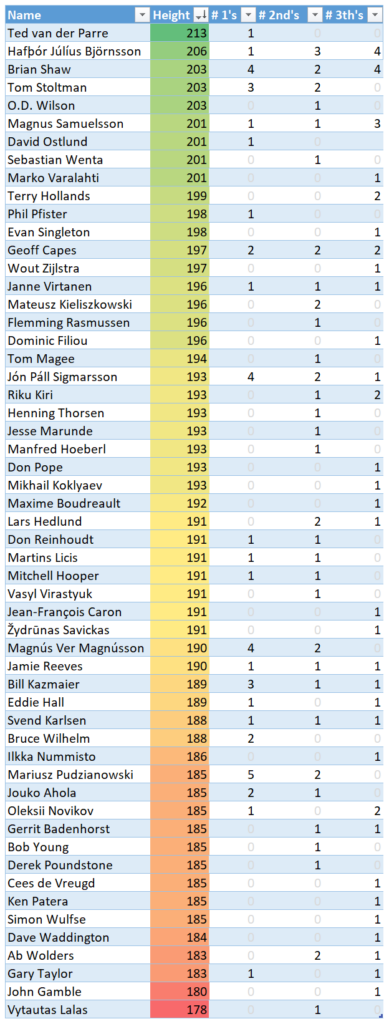
Some initial statistics based on that list: the least tall man is the Lithuanian Vytautas Lalas, with 178 cm, who won one silver medal. The tallest man is the Dutch Ted van der Parre, with 213 cm, who won one gold medal. The average height of the 55 men is 192,2 cm. As we saw above, the country with the highest average male height (i.e. 183,3 cm) is the Netherlands. Of the above 55 men, 93% are taller than the average Dutch male, and only 7% are less tall.
Rounded off to 10s and 5’s, we get the following two pivot table’s:

As we can see in the rounded-off-to-10cm table, most podium placers (81%) are in the 180 to 199 range. Looking at the rounded-off-to-5cm table, we see that the bulk of strongmen there (58%) are in the 185 to 194 range.
Because this table didn’t contain a simple column with podium wins like the previous one did, but three separate columns for the number of gold, silver and bronze medals, respectively, I decided to weigh and total those three columns to get one column with a total score. To get that score I gave three points for a gold medal, two points for silver and one point for bronze. So, for example, Brian Shaw (height: 203 cm), the strongman with the highest score, got 12 points for his four gold medals (4*3), 4 points for his two silver medals (2*2), and 4 points for his four bronze medals (4*1), totalling 20 points.
Based on the score column: the top three scores are 20 (Brian Shaw, height: 203 cm), 19 (Mariusz Pudzianowski, height: 185 cm) and 17 (Jón Páll Sigmarsson, height: 193 cm) (their average height is 193,7 cm). The lowest score is 1 (n = 15).
Based on the height and score column, I got the following scatterplot, with, again, an upgoing trendline:
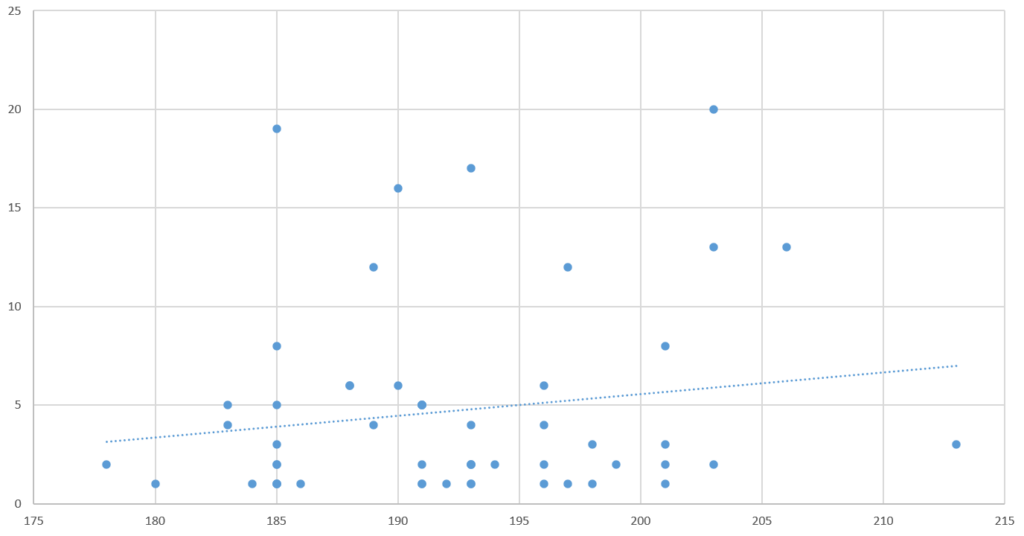
A last, dry scatterplot
As we all know, strongman events can be decided with minimal differences, a few seconds (maybe only one), sometimes just a few points difference etc. So, maybe my previous weighing method wasn’t entirely accurate. I thought another scatterplot, based on the dry total number of podium finishings, could give us a good third point of view.
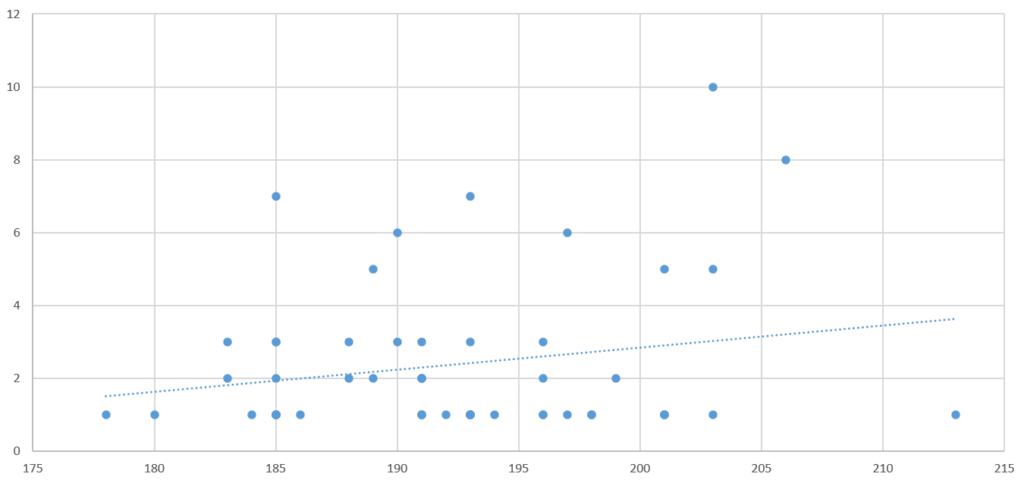
This scatterplot has the least steep, but still an obvious upgoing, trendline.
Conclusions
Based on the following of the seven facts mentioned above, which are summarized below, I would definitely say: yes, there is a very strong correlation between height and strenght.
- Of the men who had multiple WSM-podiums, 93% is taller than the average Dutch male.
- Of the men who had one or more WSM-podiums, 93% is (also) taller than the average Dutch male.
- All three scatterplots have an upgoing trendline.
- The least tall man to stand on a WSM-podium is 178 cm.
- The average height of WSM podium-placers is 192,2 cm.
- The average height of the top three WSM-podium scorers is 193,7 cm.
- 81% of the podium finishers are in the 180 to 199 cm range.
